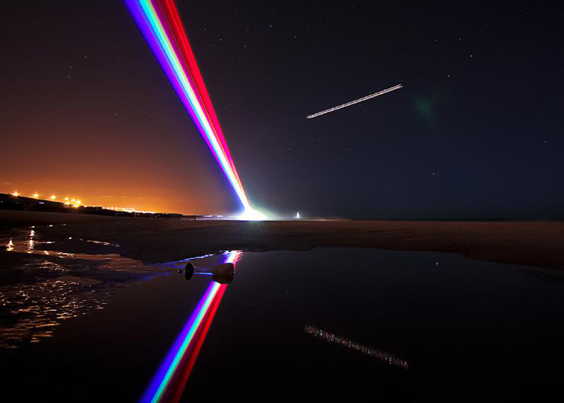
Yvette Mattern, Global Rainbow, 2009-2014 | Courtesy the artist and Scotiabank Nuit Blanche 2014
Dominique Fontaine is an independent curator based in Montreal, and amongst the four guest curators (Fontaine, Denise Markonish, Magda Gonzalez-Mora and Heather Pesanti) organizing this year’s Scotiabank Nuit Blanche in Toronto, kicking off at sunset this 4th October. Fontaine discusses her experience with M-KOS.
MKOS: How did you get involved with this year’s event?
Dominique Fontaine [DF]: A couple of years ago, I was invited to submit a proposal for Nuit Blanche. So, I submitted my proposal to the committee in Toronto who reviewed it and luckily it was accepted for this year’s event. That was a year and a half ago, and since then I’ve been working on the exhibition.
MKOS: Does Nuit Blanche have an overall theme? How did you fit your own curatorial project into this?
DF: Nuit Blanche is simply a celebration of contemporary art. Each curator proposed a project related to the specificity of Nuit Blanche, a 12 hour, overnight event attracting a massive number of Torontonians and outside visitors. My part of Nuit Blanche is entitled “Between the earth and sky, the possibility of everything” but it is not constructed like a traditional thematic exhibition. It’s rather a framework that creates a context for the audience to experience art. It brings together a vibrant variety of artists who are working in different type of materials and techniques. The idea is to propose artistic productions that tickle the brain and stimulate the senses. The inspiration for my proposal came form the artists, the qualities of their artistic productions and their relevance in the public sphere. This is how I imagined the title, as a way to present works that can change our basic assumptions about what we see, what we feel, what we understand about reality, about our worlds and ourselves.
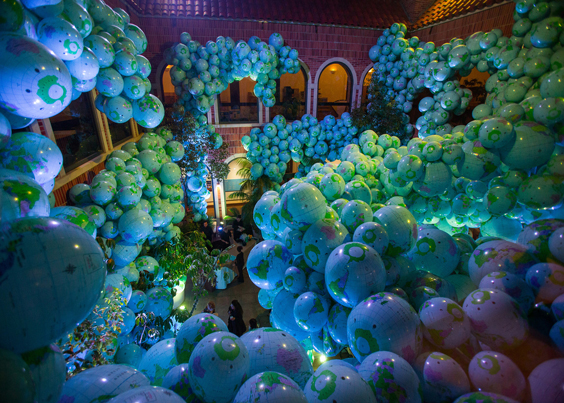
Máximo González, Walk among Worlds, 2014. Photo: Ivan Buenader. Courtesy the artist and Scotiabank Nuit Blanche 2014
MKOS: Does this encapsulate the entire project?
DF: Yes, in general, and also, my focus is to present works that are unconventional, that are also symbolic of their particular aesthetic…
MKOS: What do you mean by unconventional?
DF: I mean it’s not traditional. For example, By Means of a Sigh (À portée de souffle), an interactive video by Chloé Lefebvre and Jean Dubois. It is highly technological and it’s not a conventional piece. For this, the audience has to participate with their mobile phones to make the work comes alive. And also it makes us reflect on the idea of private and public sphere. Also, the Shy Lights by Urban Visuals, the work deals with the idea of pursuit and avoidance. Those two notions were important in conceiving the project: “Play” and “Participation”. I want the audience to be emotionally and physically engaged, while also reflecting on the issues and realities of our time: ecological concerns, climate change, sustainability and resiliency. For example Gap Ecology by David Brooks addresses eloquently issues on the built and natural environment, on opportunistic ecology, the individuals and its environment.
I consider that most of the artworks reflect current issues affecting our lives, and make us think about the future; ecologically, economically, and politically. Another example is Made in China by Maria Ezcurra, who placed an in situ installation of garments labeled ‘Made in China’ right in Chinatown. This is a poetic negotiation between the personal and the public, it exemplifies the relations from society to individuals, clashes with globalization and old customs. Walk among Worlds by Máximo González, an immersive installation of 7,000 globe shaped beach balls, is also a reflection on the political divisions of the world, but it is at the same time beautifully and poetically rendered. These are a few examples, but really all the artworks do exemplify the focus of my proposal.
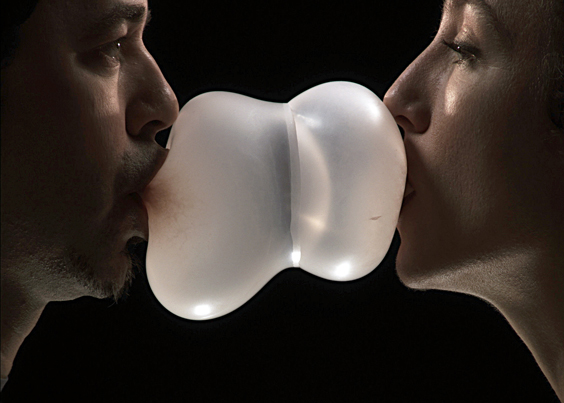
Chloé Lefebvre & Jean Dubois, By Means of a Sigh (À portée de souffle), 2008-2014. Courtesy the artists and Scotiabank Nuit Blanche 2014
MKOS: What changed in your curatorial thinking in such a public event setting, which is short lived and temporary as well as catering to a festive audience? Do such events demand to be spectacular?
DF: The productions, as much as possible, need to be monumental as well as spectacular. It is another way of conceiving an exhibition. Being outside, in an urban setting changes the cityscape into a canvas; it’s like an open-air museum, but you are dealing with thousands of visitors, different age groups and very diverse backgrounds.
When I think about exhibitions or curating, it is essential to be performative, to think about the public. I like crowds. So, for me working in this kind of setting is like a dream come true. I value the audience’s experience for encountering art in the urban framework of the city. I also think the artwork acquires renewed social energies in the context of huge crowds in the public setting. Having attended Nuit Blanche in Toronto a few times myself, I was always amazed by the reaction of the audience; the way they are captivated by the artworks. At home, we are often individually isolated in front of our screens, so this is like reclaiming back the street, a collective space celebrating art as well as to rediscover our social and sensorial possibilities.
Another particularity of the exhibition is to see the public as performer. Some of the artworks require the public to be physically active, such as, Screaming Booth by Chélanie Beaudin-Quintin, AMAZE by Marcos Zotes, Shy Lights, By Means of a Sigh and so forth.
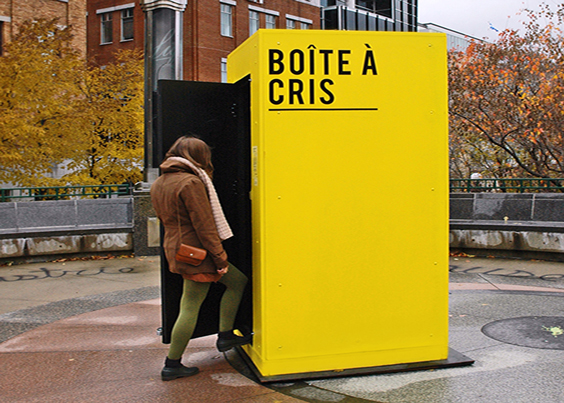
Chélanie Beaudin-Quintin, Screaming Booth, 2012. Courtesy the artist and Scotiabank Nuit Blanche 2014
MKOS: Are you presenting anything else than site specific and exterior installation?
DF: All the works are exterior or site-specific installations except Pascal Grandmaison’s video installation La main du rêve, presented at the Jackman Hall in the AGO. Because this piece requires a certain ambience to fully enjoy the sound and images in an optimal context.
MKOS: What is the most challenging aspect of curating Nuit Blanche?
DF: One of the most challenging aspects is definitely the audience. It’s very challenging to find a perfect match between what will stimulate the audience and a type of artworks to engage and inspire them as well as what will fit into this context.
MKOS: The crowd is very diverse and not necessarily art lovers.
DF: But that is why I’m very excited about this event that caters to a broader audience; it offers a chance to explore unfamiliar territory through artworks.
MKOS: What vision or thought process do you hope to infuse in the general public?
DF: I hope the audience will reconsider the meanings of play, participation and all the possibilities of public spaces; that the artworks will help them re-imagine ways to see the world, to re-experience time and space.
MKOS: What are the highlights of this year’s event for you?
DF: All the artworks are important. They are part of the exhibition especially for their qualitative and meaningful aspects. For example, Yvette Mattern’s Global Rainbow, a large-scale light sculpture that beams seven rays of laser light, is poetic and powerful. It embraces geographical and social diversity. It symbolizes, I believe, what Nuit Blanche is about, connecting all the demographics in an artistic experience. For the first time in the history of the event, one piece, Global Rainbow, will be visible across the four exhibitions areas, so that audiences will see it from all the different locations. Exciting! â–
Interviewed by Miwa Kojima
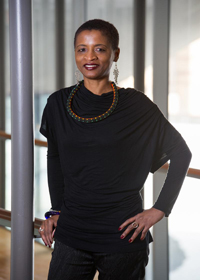
Dominique Fontaine is an independent curator and Founding Director of aPOSteRIORI, a non-profit curatorial platform. Since 1998, she has curated and organized several contemporary art events in Canada and abroad, including Images, Imageries, Imaginaires, 2010; Dak’Art 1998, Biennale of Contemporary African Art. Fontaine graduated in visual arts and arts administration from the University of Ottawa, and completed De Appel Curatorial Programme in Amsterdam (the Netherlands). Fontaine is a member of IKT – the International Association of Curators of Contemporary Art.
Scotiabank Nuit Blanche Toronto
4 October 2014, 6.43PM until sunrise
scotiabanknuitblanche.ca


One Reply to “In conversation with Dominique Fontaine, guest curator for Scotiabank Nuit Blanche Toronto 2014”